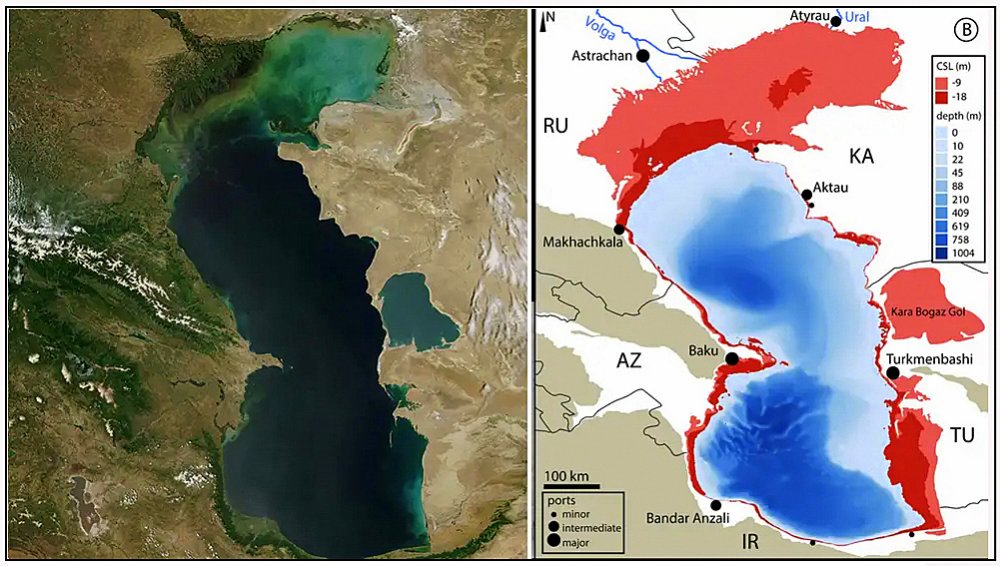Prof. Dr. Abdulvahap Kara
Experts warn of the possibility of a new ecological disaster on the Caspian Sea in recent years, similar to the drying up of the Aral Sea.
One of the important reasons for this is that the water of the Ural River is decreasing from year to year. The Ural River reaches the Caspian via the Russian Federation and Kazakhstan. Originating from the springs of Mount Necim in Bashkortostan, the river travels 2,543 km through the Chelyabinsk, Orenburg regions of Russia, and Kazakhstan’s Atyrau. Thus, by length, the Ural River is the third largest river in Europe.
From the second half of the 1980s, experts began to warn about the decrease in the water level in the Ural. As of 2018, environmentalists have used the word “disaster” frequently along with these warnings.
Alexander Chibilev, one of the world’s leading experts on the ecology of the Ural River and living in Orenburg, Russia, began to study the river in the 1980s and published many scientific articles on the subject. According to him, the shallowing of the Ural was first observed in the 1970s. This coincides with the start of the construction of hydroelectric power plants and thus large upstream reservoirs.
Today, 19 dams and large reservoirs have been built in the Ural basin. All of them are located on the territory of the Russian Federation, in the Orenburg and Chelyabinsk regions. In total, the Ural river has 58 tributaries. The largest of these branches are Sakmara, Elek and Çağan. Since the construction of the Iriklinsky reservoir in the Upper Ural, 80% of the river water comes from Sakmara.
Apart from this, the activities of new agricultural and industrial establishments intensified in the Ural basin in the 1970s. Growing and cultivation of vegetable, fruit and livestock farms, which had very high rates of development by Soviet standards, required the use of more and more water.
In addition to these, it is a fact that the ups and downs of the continental climate and the global warming in the world in general affect the water of the river negatively.
The Caspian Sea, which is not connected to the oceans and seas, is shrinking by 7 cm per year, and the shallow northern part is currently only 4-6 meters deep. For many years, this part of the sea once served as a source of livelihood for coastal people who hunted fish and caviar of the Caspian Sea.
This area was a spawning ground for aquatic creatures such as beluga, sturgeon, Caspian seals and other fish, as well as migratory birds such as pink flamingos.
The shallowing of the water of the North Caspian brings the risk of extinction of this unique ecosystem, which already includes endangered Caspian seals. The risk is already high due to pollution from oil production and sewage discharge, overexploitation and poaching by locals trying to make a living.
Doing research on marine biodiversity at the Naturalis Nature Museum and Research Center in Leiden, Netherlands. Frank Wesselingh says, “Most of the important fishing areas around the North Caspian may disappear” and emphasizes that if measures are not taken, the negative consequences will be enormous, especially for the people living in the region.
Research shows that if the necessary studies are not done, the Caspian Sea may fall 9-18 meters and lose 25-30% of its surface area by the end of this century. Falling sea levels will have a devastating impact not only on the environment and economy of neighboring countries, but also on the geopolitical situation already strained by uncertain maritime borders, shipping waterways and fishing rights.
Ignoring the problem could certainly lead to an environmental disaster akin to what remains of ghost ports and the dying Aral Sea. Together, Russia and Kazakhstan are seeking remedies to improve the disastrous condition of the Ural River.
The first Russian-Kazakhstan agreement on the joint use and protection of the country’s transboundary natural assets was signed in 1992. Later, an intergovernmental commission was also created. Also in 2018, a meeting of the Russian-Kazakh Commission was held, where aspects of practical environmental work were significantly discussed.
In June 2019, at the International Environment Forum, it was decided to create a bilateral intergovernmental body for the protection of the Urals. A detailed program was developed for the restoration of the Ural ecosystem, within the framework of this program a specific action plan and roadmap were approved and a working group was formed.
The recent joint efforts by Russia and Kazakhstan show that the seriousness of the ecological crisis in the Ural Basin is understood, but so far no concrete steps have been taken to address the pressing issues.
In his speech at the 6th Caspian Summit held in Ashgabat, the capital of Turkmenistan on June 29, 2022, President of Kazakhstan Kassym-Jomart Tokayev called for participation in the efforts to prepare a joint action plan to improve the situation of the Ural River. In his speech, Tokayev said, “We have a responsibility to take joint and effective measures to save the Ural River, otherwise there will be nothing left to save in the future. We call on all parties to unite efforts and draw up a joint action plan to improve the Ural River,” he said.
As a result, urgent and coordinated action is needed to make up for the precious time lost, unless the Caspian Sea is destined for the fate of the Aral Sea to dry out to a great extent. In this respect, it is important that Kazakhstan and Russia implement measures to save the Ural river, which provides significant water to the Caspian, by providing a mutually beneficial, science-based cooperation that takes into account not only their environmental but also economic interests. /// nCa, 1 February 2023
Originally published in Turkish language by Önce Vatan Gazetesi at this link: https://www.oncevatan.com.tr/hazarin-kaderi-makale,56018.html
